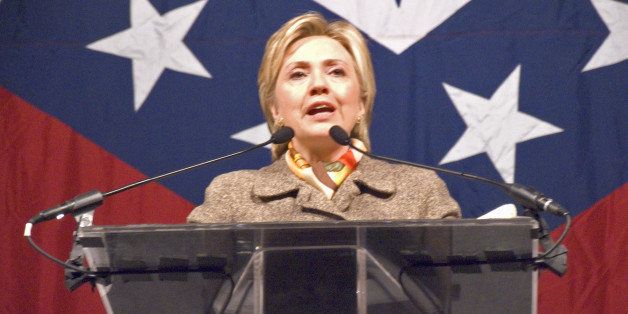
The theoretical notion of "intersectionality," as originally articulated by Kimberlé Crenshaw in her 1991 groundbreaking Stanford Law Review essay, was recently revisited in her 2015 Washington Post essay "Why Intersectionality Can't Wait." In this essay, Crenshaw makes a case for using intersectionality, as a framework, for analyzing racial, sexual and economic justice--the very issues that are at the forefront of this year's Presidential Election. Crenshaw states: "intersectionality was a lived reality before it became a term."
At the end of the day, when individuals are supporting, or not supporting a political candidate, our voting choices are informed by just that: our lived realities. As a critical scholar, my work is informed by theories of intersectional feminism(s)--understanding how categories of race, class, gender and sexuality, within institutional structures, affect bodies. What is clear in adopting an intersectional feminist approach to discussing societies most pressing issues, is that one must attempt to understand how some categories are more salient, and interact with other identity categories. However, when one analyses the media framing of the current Presidential election, this nuanced analysis is lacking. Perhaps most clearly is this "lack" seen in the dominant discourse surrounding Hillary Clinton's bid to shatter the glass ceiling, and become the first female President of the United States.
Let's look at, for example, some of the recent quotes pertaining to female voters' decisions as to whether or not they should support Hillary's candidacy. Madeline Albright, when asked about Hillary as our first female President, remarked: there is a "special place in hell" for women who do not support Hillary for President. Gloria Steinem, appearing on the "Real Time with Bill Maher" show, when attempting to explain why young women are not supporting Hillary for President explained that women "are going where the boys are, and the boys are with Sanders." Bernie Sanders supporters also invoked gender as a monolithic category by accusing female Clinton supporters of being "vagina voters," swayed by "shared anatomy, rather than their candidate's qualifications and positions." These discourses, which are repeated widely, among all mainstream media outlets, reflect a narrow and inadequate understanding of gender, in relation to other identity categories (e.g., race, class, gender, sexuality) and institutional structures of power in contemporary society. The centering of gender, simultaneously de-centers other critical categories of analysis that are critical to the populous voting bloc, in decision-making processes, and renders other, more critical explanations for Hillary's "women problem," invisible.
First, we must interrogate the premise that Hillary does, in fact, have a "women problem," when it comes to female voters. When analyzing the most recent credible presidential polls, to find evidence as to how Hillary is polling with the female voting block, when placed head-to-head with the presumptive Republican nominee, Donald Trump, Hillary holds strong favorable margins across conservative, liberal and independent polls. Even the conservative Fox News poll has her at a crushing +22, amongst all female voters, and ahead with women in key battleground states.
However, when you break the polling down to young female voters, differences across those aforementioned intersectional categories, begin to emerge. For example, according to recent polls, in relation to Hillary's candidacy, a generational gap amongst female voters does indeed exist. Many more middle-aged, or older women (30-49) support Hillary, versus the millennial generation (18-29) of young female voters, who, up until Bernie Sanders dropped out of the race, were zealot Bernie-or-bust supporters. In fact, in recent polls before Bernie backed Hillary had Sanders leading Clinton among young voters, overall, by as much as 60 points, while Clinton loses young women by about 30 points. The task now then, for the Hillary camp, is to attempt to understand, between now and November, these reported ideological voting disconnects, in order to become the first Female President. While Hillary's exigence is in securing the White House, my interest lies in applying intersectional understandings of feminisms in order to offer insight into how categories of race, class, gender and sexuality are embodied within the mainstream political system.
Some pundits have claimed that the female generational gap amongst potential Hillary supporters is due to young women not viewing themselves, or identifying as feminists. However, these claims are disputed by a national survey conducted in January of this year, by the Washington Post and the Kaiser Family Foundation. The survey found that 6 in 10 women and one-third of men call themselves a "feminist," or "strong feminist," with roughly 7 in 10 of each reporting feminist movement as "empowering." Moreover, when we look at young female voters, feminism, as a category, is strong. For instance, 63% of women who fall between the ages of 18-34 identified as "strongly feminists" or "feminist."
But this still begs the question, why the gender divide? First, we must remember that there are many different types of feminisms. This poll does not ask respondents to list what type of feminism they ascribe to. In addition, feminism is not just a label. It is an identity and an analytic category used to make sense of lived experiences. As such, young women, as they are just beginning their lives, do not have as much life experience in relation to things such as discrimination on the job market, or childcare--issues that have been staples for a Hillary candidacy, for decades. Therefore, in addition to a disconnect between Hillary's articulated gender challenges for women, issues of economic justice, which poll as extremely important to young female voters, was completely dominated by Sanders. Indeed, Bernie's strongly articulated tropes such as "the 1%," "Wall Street greed," and "corporate corruption" all went in the Bernie column. Now that Bernie has dropped out of the race, Hillary's platform must embrace the economic concerns of young women/women of color.
The evidence for the necessity of embracing intersectional feminism to understand voting patterns is further evidenced by "GenForward"--a survey project enacted by the Black Youth Project at the University of Chicago, with the Associated Press, Center for Public Affairs Research. The first-of-its-kind polling pays particular attention to the voices of young adults of color, "highlighting how race and ethnicity shape the opinions of the country's most diverse generation."
Hillary's campaign is beginning to see the necessity of this more nuanced analysis. Recently, in fact, her team has hired three former Sanders aides to spearhead an effort to bridge this gap: "Clinton has made moves in recent days to attract some of Sander's loyal young supporters, including unveiling a college affordability plan that would make in-state tuition free for families making $125,000 or less per year. Sanders proposed free tuition at public higher education institutions for all, a plan supported by three-quarters of young adults, according to the survey."
Here, we see a move beyond gender, to attempt to address economic justice. We see a (perhaps) not so subtle shift of Hillary's departure of her comfort zone discourses of "battles of the sexes," which have its roots in second wave feminism, from Hillary's generation, in an attempt to catch up to critical discussions which have emerged, of late, within popular culture--discourses on racial and economic justice, in relation to privilege.
So, yes, Hillary would be our first female president. But theories of intersectionality and feminism seek to understand what type of female president? When that question is answered, we are left with the stark image of a privileged, White, rich straight Woman. Viewed through this lens, not only is Clinton's gender not enough to secure the young women's vote it, in fact, may be a negative. One need only examine the multitude of tweets regarding Hilary's bid to make herstory. Hashtags such as #I'mnotwithher #Notmyfeminist, etc., function to conjure these critical limitations, of her identity, into reality. The limits of gender, as a driving category, are brought to bear when they intersect with her record on issues that permeate the categories of race, class and sexuality. Issues such as transphobia, the prison pipeline, imperial wars, to name a few, are not only categories of non-support, but also categories that function as warrants for claims, and campaigns against.
Young voters are also disenfranchised with the system, itself, that propels Hillary as a candidate. As reported by GenForward: "Indeed, 7 out of 10 young voters, including Blacks, Whites, Asian and Hispanics [sic] state that they are unsatisfied with the race between Clinton and Trump and want the option of a third party candidate."
In sum, I contend, not only does intersectional feminism offer an understanding of young female voters' rejections of Hillary as a candidate, it also offers insight into the rejection of the political system itself. As Crenshaw, herself, reminds us: "intersectionality is not just about identities but about the institutions [emphasis added] that use identity to exclude and privilege."
The very real possibility of Hillary Diane Rodham Clinton, shattering the glass ceiling of the most important building in the land, the White House, should be marked for its historical significance. However, for young women, and the thousands of others who do not support Hillary, the early calls for celebration fall flat. Perhaps, instead of asking why Hillary has a "female voter problem," perhaps a more important question to ask may be: in the shattering of this glass ceiling, who has been damaged by the falling chards--and, who will be left picking up the thousands of shattered pieces on Wednesday November 09?
